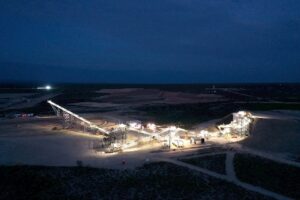The rumble in the background is not from tectonic plates; but from truckloads of household commodities leaving the state North of 60 Mining News – May 5, 2023Let’s talk about electric car batteries, their mineral content, the source of the minerals, and where those minerals are refined.Generally speaking, according to a recent piece in the Washington Post, electric car batteries weigh about 900 pounds – 900 pounds of minerals that have to be mined, refined, combined and shaped, fitted and installed into cars – cars that are being pushed onto the American public because they don’t require polluting gasoline.We are told that electric vehicles reduce carbon emissions – from the vehicle, but not necessarily from the electric generation facility. We are not generally told that they require up to six times as many minerals, by weight, as conventional cars.Electric car batteries may require aluminum (18.9%), cobalt (4.3%), nickel (15.7%), lithium (3.2%) and manganese (5.4%), among other, more conventional, minerals.The bauxite for aluminum principally comes from Guinea, Australia, and China. The nickel is recovered mostly from Indonesia and the Philippines and, to some extent, New Caledonia, Russia, Australia, and Canada. Manganese mines are in South Africa, Gabon, and Australia, with some in China and Ghana. Lithium currently originates mostly from Australia, the Chile-Argentina-Bolivia “lithium triangle,” and China, with substantial, untapped reserves in Afghanistan. 70% of the world’s cobalt is mined in the Democratic Republic of Congo.Despite of global distribution of these minerals, the big player in their refinement is China. Chinese refineries produce 95% of the world’s manganese, 65% of the cobalt, 58% of the lithium, 56% of the aluminum, and 35% of the nickel. In other words, China controls the bulk of the world’s refining capability and roughly three-quarters of the world’s battery production capacity.Where is the production contribution of the United States? What is Alaska’s role? Simply put, the U.S., in general, and Alaska, in particular, prefers to keep its ample mineral treasures in the ground, hidden under vast, magnificent viewsheds that tourists rarely see and where the local subsistence economy cannot afford milk or gasoline.We have many of these resources within the state, in significant quantities, but we choose to protect them for the benefit of generations yet unborn.Investors, interestingly enough, have watched the price of commodities surge as the demand for the forgoing “green” minerals has increased. According to a recent article in The Economist, “as dealmaking slumped in other sectors, mining bosses shook hands at a rate not seen in decades.”A global shortage of copper has been projected for decades. The requirement for green metals, driven by expected sales of electric vehicles, is anticipated to precipitate 50% or more of the additional demand for this decade. And the major mining companies are taking full advantage of the opportunity. In December, for instance, Rio Tinto secured a majority interest in Oyu Tolgoi, the Mongolian copper project, while in multi-billion-dollar transactions, BHP is taking over Oz Minerals and Newmont is seeking to acquire Newcrest.Traditionally, commodities lead the way out of difficult economic times. Some would argue that mineral production from the American West financed the defeat of the Confederacy in the 19th Century. Domestic mineral production in the 1940s indubitably bolstered the Allied victory in World War II.Today, the global production of minerals in the face of threats of economic recession and catastrophic climate change suggests that the future is bright economically and bright green, just not for Alaska. The crossroads in front of us presents a difficult challenge.Americans viscerally know and understand that we need increased production of commodities. We also know where those domestic mineral deposits are, and we know how to mine them in an environmentally safe, humanitarian way. We even have some level of government support for sourcing required minerals from our own reserves, at least when it comes to electric vehicles. For reasons that defy logic, however, our leaders will not permit our mining industry to turn a shovel when it comes to new mines in Alaska, even in the face of palpable need.It is often said that America is “divided.” I am not sure that a difference of opinion rises to a “division,” but certainly, there is unanimity on our desire to have those things that mineral production provides. Likewise, there is unanimous agreement that the minerals must be produced using methods and means that protect the health of the environment and the safety of the miners. Where we meet ourselves at the door, going both ways at the same time, is over the question of preserving large tracts of remote land for posterity in exchange for potential present prosperity.Alaska is losing its population rapidly. Tourism will never fill the gap. Oil and gas can be recovered elsewhere cheaper. Alaska’s potential for mineral production is massive, but at some point, we need to embrace, not erase, mining.Perhaps electric vehicles are the answer to reducing automotive air pollution, but unless and until we are able to permit several more mines in Alaska soon, it may be a pyrrhic victory.
This article was published by:
Visit the original article here

Persimmon completes land deal at major South West housing scheme
Reading Time: 2 minutes Persimmon has completed a deal to purchase more land at the Cranbook new town near


